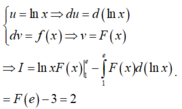Hãy nhập câu hỏi của bạn vào đây, nếu là tài khoản VIP, bạn sẽ được ưu tiên trả lời.

Nhìn 2 vế của hàm số thì có vẻ ta cần phân tích biểu thức vế trái về dạng \(\left[f\left(x\right).u\left(x\right)\right]'=f\left(x\right).u'\left(x\right)+u\left(x\right).f'\left(x\right)\), ta cần tìm thằng \(u\left(x\right)\) này
Biến đổi 1 chút xíu: \(\frac{\left[f\left(x\right).u\left(x\right)\right]'}{u\left(x\right)}=\frac{u'\left(x\right)}{u\left(x\right)}f\left(x\right)+f'\left(x\right)\) (1) hay vào bài toán:
\(\left(\frac{x+2}{x+1}\right)f\left(x\right)+f'\left(x\right)=\frac{e^x}{x+1}\) (2)
Nhìn (1) và (2) thì rõ ràng ta thấy \(\frac{u'\left(x\right)}{u\left(x\right)}=\frac{x+2}{x+1}=1+\frac{1}{x+1}\)
Lấy nguyên hàm 2 vế:
\(ln\left(u\left(x\right)\right)=\int\left(1+\frac{1}{x+1}\right)dx=x+ln\left(x+1\right)\)
\(\Rightarrow u\left(x\right)=e^{x+ln\left(x+1\right)}=e^x.e^{ln\left(x+1\right)}=e^x.\left(x+1\right)\)
Vậy ta đã tìm xong hàm \(u\left(x\right)\)
Vế trái bây giờ cần biến đổi về dạng:
\(\left[f\left(x\right).e^x\left(x+1\right)\right]'=e^x\left(x+2\right).f\left(x\right)+f'\left(x\right).e^x\left(x+1\right).f'\left(x\right)\)
Để tạo thành điều này, ta cần nhân \(e^x\) vào 2 vế của biểu thức ban đầu:
\(e^x\left(x+2\right)f\left(x\right)+e^x\left(x+1\right)f'\left(x\right)=e^{2x}\)
\(\Leftrightarrow\left[f\left(x\right).e^x.\left(x+1\right)\right]'=e^{2x}\)
Lấy nguyên hàm 2 vế:
\(f\left(x\right).e^x\left(x+1\right)=\int e^{2x}dx=\frac{1}{2}e^{2x}+C\)
Do \(f\left(0\right)=\frac{1}{2}\Rightarrow f\left(0\right).e^0=\frac{1}{2}e^0+C\Rightarrow C=0\)
Vậy \(f\left(x\right).e^x\left(x+1\right)=\frac{1}{2}e^{2x}\Rightarrow f\left(x\right)=\frac{1}{2}\frac{e^{2x}}{e^x\left(x+1\right)}=\frac{e^x}{2\left(x+1\right)}\)
\(\Rightarrow f\left(2\right)=\frac{e^2}{2\left(2+1\right)}=\frac{e^2}{6}\)

a: \(y=\left(2x^2-x+1\right)^{\dfrac{1}{3}}\)
=>\(y'=\dfrac{1}{3}\left(2x^2-x+1\right)^{\dfrac{1}{3}-1}\cdot\left(2x^2-x+1\right)'\)
\(=\dfrac{1}{3}\cdot\left(4x-1\right)\left(2x^2-x+1\right)^{-\dfrac{2}{3}}\)
b: \(y=\left(3x+1\right)^{\Omega}\)
=>\(y'=\Omega\cdot\left(3x+1\right)'\cdot\left(3x+1\right)^{\Omega-1}\)
=>\(y'=3\Omega\left(3x+1\right)^{\Omega-1}\)
c: \(y=\sqrt[3]{\dfrac{1}{x-1}}\)
=>\(y'=\dfrac{\left(\dfrac{1}{x-1}\right)'}{3\cdot\sqrt[3]{\left(\dfrac{1}{x-1}\right)^2}}\)
\(=\dfrac{\dfrac{1'\left(x-1\right)-\left(x-1\right)'\cdot1}{\left(x-1\right)^2}}{\dfrac{3}{\sqrt[3]{\left(x-1\right)^2}}}\)
\(=\dfrac{-x}{\left(x-1\right)^2}\cdot\dfrac{\sqrt[3]{\left(x-1\right)^2}}{3}\)
\(=\dfrac{-x}{\sqrt[3]{\left(x-1\right)^4}\cdot3}\)
d: \(y=log_3\left(\dfrac{x+1}{x-1}\right)\)
\(\Leftrightarrow y'=\dfrac{\left(\dfrac{x+1}{x-1}\right)'}{\dfrac{x+1}{x-1}\cdot ln3}\)
\(\Leftrightarrow y'=\dfrac{\left(x+1\right)'\left(x-1\right)-\left(x+1\right)\left(x-1\right)'}{\left(x-1\right)^2}:\dfrac{ln3\left(x+1\right)}{x-1}\)
\(\Leftrightarrow y'=\dfrac{x-1-x-1}{\left(x-1\right)^2}\cdot\dfrac{x-1}{ln3\cdot\left(x+1\right)}\)
\(\Leftrightarrow y'=\dfrac{-2}{\left(x-1\right)\cdot\left(x+1\right)\cdot ln3}\)
e: \(y=3^{x^2}\)
=>\(y'=\left(x^2\right)'\cdot ln3\cdot3^{x^2}=2x\cdot ln3\cdot3^{x^2}\)
f: \(y=\left(\dfrac{1}{2}\right)^{x^2-1}\)
=>\(y'=\left(x^2-1\right)'\cdot ln\left(\dfrac{1}{2}\right)\cdot\left(\dfrac{1}{2}\right)^{x^2-1}=2x\cdot ln\left(\dfrac{1}{2}\right)\cdot\left(\dfrac{1}{2}\right)^{x^2-1}\)
h: \(y=\left(x+1\right)\cdot e^{cosx}\)
=>\(y'=\left(x+1\right)'\cdot e^{cosx}+\left(x+1\right)\cdot\left(e^{cosx}\right)'\)
=>\(y'=e^{cosx}+\left(x+1\right)\cdot\left(cosx\right)'\cdot e^u\)
\(=e^{cosx}+\left(x+1\right)\cdot\left(-sinx\right)\cdot e^u\)
a) \(y=\left(2x^2-x+1\right)^{\dfrac{1}{3}}\)
\(\Rightarrow y'=\dfrac{1}{3}.\left(2x^2-x+1\right)^{\dfrac{1}{3}-1}.\left(4x-1\right)\)
\(\Rightarrow y'=\dfrac{1}{3}.\left(2x^2-x+1\right)^{-\dfrac{2}{3}}.\left(4x-1\right)\)
b) \(y=\left(3x+1\right)^{\pi}\)
\(\Rightarrow y'=\pi.\left(3x+1\right)^{\pi-1}.3=3\pi.\left(3x+1\right)^{\pi-1}\)
c) \(y=\sqrt[3]{\dfrac{1}{x-1}}\)
\(\Rightarrow y'=\dfrac{\left(x-1\right)^{-1-1}}{3\sqrt[3]{\left(\dfrac{1}{x-1}\right)^{3-1}}}=\dfrac{\left(x-1\right)^{-2}}{3\sqrt[3]{\left(\dfrac{1}{x-1}\right)^2}}=\dfrac{1}{3.\sqrt[]{x-1}.\sqrt[3]{\left(\dfrac{1}{x-1}\right)^2}}\)
\(\Rightarrow y'=\dfrac{1}{3\left(x-1\right)^{\dfrac{1}{2}}.\left(x-1\right)^{\dfrac{2}{3}}}=\dfrac{1}{3\left(x-1\right)^{\dfrac{7}{6}}}=\dfrac{1}{3\sqrt[6]{\left(x-1\right)^7}}\)
d) \(y=\log_3\left(\dfrac{x+1}{x-1}\right)\)
\(\Rightarrow y'=\dfrac{\dfrac{1-\left(-1\right)}{\left(x-1\right)^2}}{\dfrac{x+1}{x-1}.\ln3}=\dfrac{2}{\left(x+1\right)\left(x-1\right).\ln3}\)
e) \(y=3^{x^2}\)
\(\Rightarrow y'=3^{x^2}.ln3.2x=2x.3^{x^2}.ln3\)
f) \(y=\left(\dfrac{1}{2}\right)^{x^2-1}\)
\(\Rightarrow y'=\left(\dfrac{1}{2}\right)^{x^2-1}.ln\dfrac{1}{2}.2x=2x.\left(\dfrac{1}{2}\right)^{x^2-1}.ln\dfrac{1}{2}\)
Các bài còn lại bạn tự làm nhé!


a) Điều kiện x>0. Thực hiện chia tử cho mẫu ta được:
f(x) = =
=
∫f(x)dx = ∫()dx =
+C
b) Ta có f(x) = =
-e-x
; do đó nguyên hàm của f(x) là:
F(x)= =
=
+ C
c) Ta có f(x) =
hoặc f(x) =
Do đó nguyên hàm của f(x) là F(x)= -2cot2x + C
d) Áp dụng công thức biến tích thành tổng:
f(x) =sin5xcos3x = (sin8x +sin2x).
Vậy nguyên hàm của hàm số f(x) là F(x) = -(
cos8x + cos2x) +C
e) ta có
vậy nguyên hàm của hàm số f(x) là F(x) = tanx - x + C
g) Ta có ∫e3-2xdx= -∫e3-2xd(3-2x)= -
e3-2x +C
h) Ta có :
= =

\(f'\left(x\right)=0\) có 3 nghiệm \(x=-1;0;2\)
Dấu của \(f'\left(x\right)\) trên trục số:

Ta thấy có 2 lần \(f'\left(x\right)\) đổi dấu từ âm sang dương nên hàm có 2 cực tiểu

d: ĐKXĐ: \(x^2-1< >0\)
=>\(x^2\ne1\)
=>\(x\notin\left\{1;-1\right\}\)
Vậy: TXĐ là D=R\{1;-1}
b: ĐKXĐ: \(2-x^2>0\)
=>\(x^2< 2\)
=>\(-\sqrt{2}< x< \sqrt{2}\)
Vậy: TXĐ là \(D=\left(-\sqrt{2};\sqrt{2}\right)\)
a: ĐKXĐ: \(x-1>0\)
=>x>1
Vậy: TXĐ là \(D=\left(1;+\infty\right)\)
c: ĐKXĐ: \(x^2+x-6>0\)
=>\(x^2+3x-2x-6>0\)
=>\(\left(x+3\right)\left(x-2\right)>0\)
TH1: \(\left\{{}\begin{matrix}x+3>0\\x-2>0\end{matrix}\right.\)
=>\(\left\{{}\begin{matrix}x>2\\x>-3\end{matrix}\right.\)
=>x>2
TH2: \(\left\{{}\begin{matrix}x+3< 0\\x-2< 0\end{matrix}\right.\)
=>\(\left\{{}\begin{matrix}x< -3\\x< 2\end{matrix}\right.\)
=>x<-3
Vậy: TXĐ là \(D=\left(2;+\infty\right)\cup\left(-\infty;-3\right)\)
e: ĐKXĐ: \(x^2-2>0\)
=>\(x^2>2\)
=>\(\left[{}\begin{matrix}x>\sqrt{2}\\x< -\sqrt{2}\end{matrix}\right.\)
Vậy: TXĐ là \(D=\left(-\infty;-\sqrt{2}\right)\cup\left(\sqrt{2};+\infty\right)\)
f: ĐKXĐ: \(\sqrt{x-1}>0\)
=>x-1>0
=>x>1
Vậy: TXĐ là \(D=\left(1;+\infty\right)\)
g: ĐKXĐ: \(x^2+x-6>0\)
=>\(\left(x+3\right)\left(x-2\right)>0\)
=>\(\left[{}\begin{matrix}x>2\\x< -3\end{matrix}\right.\)
Vậy: TXĐ là \(D=\left(2;+\infty\right)\cup\left(-\infty;-3\right)\)


Đáp án A